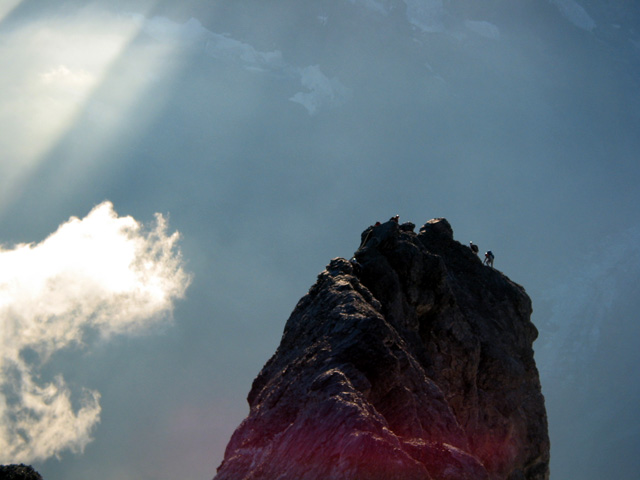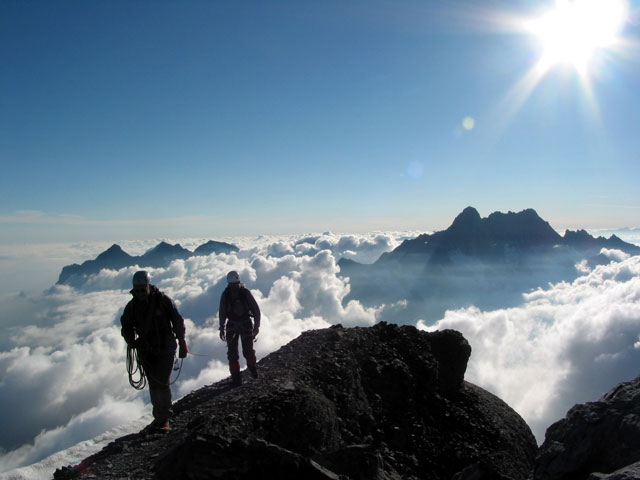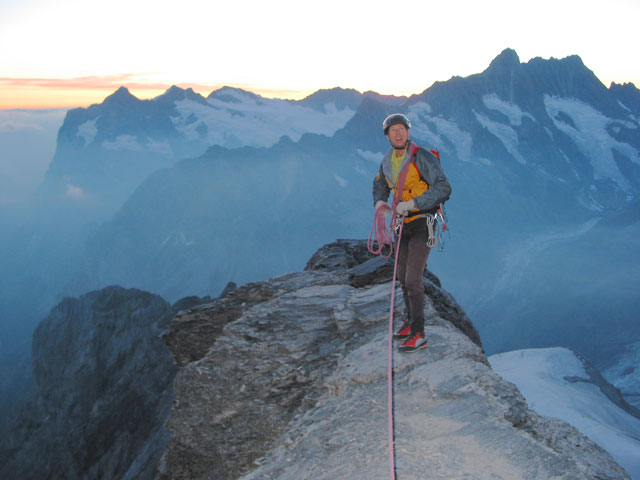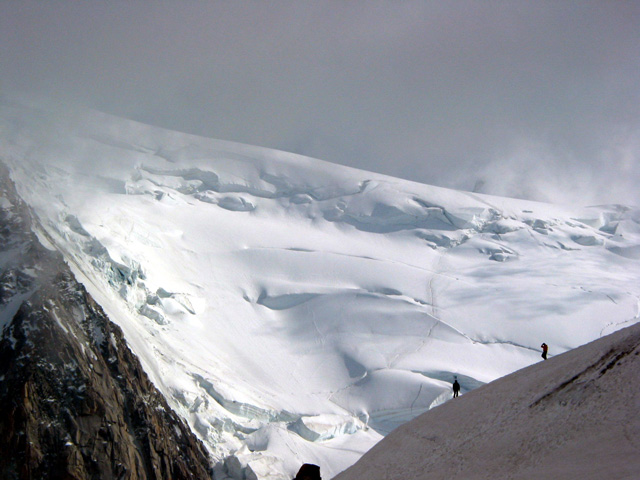 ™
™TRADITIONAL MOUNTAINEERING ™
 ™
™
FREE BASIC TO ADVANCED ALPINE MOUNTAIN CLIMBING INSTRUCTION
™
Home
| Information
| Photos
| Calendar
| News
| Seminars
| Experiences
| Questions
| Updates
| Books
| Conditions
| Links
| Search
![]()



Copyright© 2004 by Michael Powers. All Rights Reserved.
Photos one to three are of the Eiger summit.
The photo above shows the traverse via Mont Blanc du Tacul. See below.
Guiding the Eiger, Matterhorn and Mont Blanc
Since the birth of mountaineering, these three peaks have held the fascination
of the climbing public like no others: Mont Blanc because its ascent heralded
the dawn of alpine climbing, and because its 15,771-foot summit is the highest
point in Western Europe; the Matterhorn because of its appearance as an
unclimbable rock tower; and the Eiger, with its dark, brooding North Face, the
last of the “Three Great Problems” to be conquered.
Though now climbed regularly, these peaks still offer a unique and unmistakable
alpine challenge, and the character of the climbing encountered on them is as
diverse as the peaks themselves. On Mont Blanc the primary challenge is high
altitude glacier climbing, where weather, snow and ice conditions,
acclimatization, and personal fitness all combine to provide the key to a
successful summit climb. In contrast, the ascents of the Eiger and Matterhorn
call upon technical rock skills and the ability to move quickly and efficiently
along the spiny crests of their exposed alpine ridges. Because the three peaks
are located in very different parts of the Alps, each gives the climber an
unusual opportunity to explore the cultural and environmental diversity of this
magnificent mountain range.
AAI offers a seven-day program to climb Mont Blanc and the Matterhorn and a
three-day optional extension to climb the Eiger. We also can make the
spectacular traverse of the Breithorn or climb other peaks in the area if
conditions at the time of our climb keep us off the Matterhorn, and we can make
the classic ascent of the Jungfrau if the Eiger goes out of shape. Most of the
routes are done at a 2:1 ratio, with the exception of the Matterhorn and the
Eiger which are both done at a 1:1 ratio. As described below, the peaks can also
be climbed individually, but warm-up climbs are required both for technical
review and for acclimatization.
Mont Blanc –
The route we choose on Mont Blanc will depend on conditions, but we most
typically climb the Goûter Route or a traverse via Mont Blanc du Tacul and Mont
Maudit. After a night spent in a high alpine refuge, we rise very early to take
advantage of the frozen snow of the early morning hours. Our routes wind their
way up the immense glaciers which cover the entire north and west sides of Mont
Blanc, eventually leading to a dramatic ridge crest and Western Europe's highest
summit. Surrounded by immense glaciers and offering views of some of the most
beautiful alpine peaks in the world, this is an impressive and photogenic climb
from beginning to end.
The Matterhorn –
This looming rock tower truly dominates the valley town of Zermatt (5257
feet). Rising 9500 feet above the valley, like Mont Blanc the Matterhorn stands
as one of the great symbols of mountaineering achievement. In 1865 this dark
rock tower remained one of the final major unclimbed summits of the Alps. When
at last Whymper's party was successful in reaching the airy summit on July 14 of
that year, a tragic accident on the descent, in which four of the seven climbers
were killed, only served to increase the mountain's reputation of
impregnability. Made easier by the presence of fixed ropes and other anchors,
today the climb does not appear so fearsome as it did over a century ago.
However, it still remains a long and very exposed route and one which offers the
climber significant challenges. After a night in the Hörnli Hut we ascend the
arête of the same name which rises nearly in a straight line to the 14,691-foot
summit astride the Swiss and Italian border. The route is almost entirely on
rock with only occasional snow patches where we leave the sharp ridge crest and
climb gullies and chimneys on its flanks.
The Eiger –
In the heart of the Bernese Oberland, classic wooden Swiss chalets dot the
hillsides amid green fields of grass and flowers. No other part of Switzerland
epitomizes the traditional alpine vista as well as the valleys of Grindelwald
and Lauterbrunnen. Our route of ascent on the Eiger is the Mittellegi Ridge, a
fine dividing line between the mile-high North Face and the Fiescher Glacier.
Our approach to this seemingly remote ridge is via the incredible Jungfraujoch
Railway which enters on the west side of the Eiger, tunnels through the peak,
passes the infamous North Face “windows” (often used as routes of retreat for
storm-battered Eigerwand climbers), and finally emerges high on the southeast
face at the Eismeer station at 10,364 feet. We disembark, traverse the upper
reaches of the Fiescher Glacier, and climb the final slopes to the Mittellegi
Hut which stands on the ridge at just over 11,000 feet. From here the route
climbs steadily along the exposed ridge to the Eiger's summit, mixing third,
fourth, and fifth class rock climbing and offering significant exposure.
Prerequisites –
For any of these challenging climbs, you need to be in excellent physical
condition and be able to climb 4000 feet in 4 hours including rest stops while
carrying a 25 pound pack. You should also have experience with glacier travel
and the use of crampons and ice axe in all fundamental techniques. For the
Matterhorn and the Eiger, you need to have multi-pitch Class 5 rock climbing
experience, be comfortable following at least 5.7, and have made 5th class
ascents in mountaineering boots.
Program Descriptions
4 or 6-Day Chamonix - Mont Blanc Program
After an orientation in Chamonix, France, the program begins with a one-day
ascent of the Cosmiques Arête on the Aiguille du Midi (12,602'). This classic
mixed route gives us a chance to become acquainted with the Mont Blanc Massif
and to begin the process of acclimatization in preparation for our ascent of
Mont Blanc. In addition to the Aiguille du Midi, we review glacier skills or
make a second ascent before tackling Mont Blanc (possibilities are the East
Arête of the Pyramide du Tacul or the Midi-Plan Traverse).
5-Day Zermatt - Matterhorn Program
We meet in the alpine village of Zermatt, Switzerland, and begin our series
of ascents with a two-day climb of the photogenic Rothorn. We approach a high
hut by hiking through a beautiful alpine valley and gorge; on summit day we
enjoy moderate glacial terrain, the climb of a moderately steep snow face to
reach a ridge, and spectacular mid-fifth class rock climbing on a sharp arête
that takes us right to the summit. Our second ascent is on the famous Breithorn
which rises between Monte Rosa and the Matterhorn. We make an airy traverse of
this peak on snow, ice, and rock, climbing and rappelling a series of horns as
we make our way to the summit. We then have an easy day as we make our way to
the Hörnli Hut and prepare for summit day on the Matterhorn.
7-Day Mt. Blanc and Matterhorn Program
Those wishing to experience two of the finest alpine routes that France and
Switzerland have to offer may climb Mt. Blanc and the Matterhorn in a single
seven-day program. We begin with climbs in the Chamonix area, then travel by
train to Zermatt. This program offers a great deal of flexibility for those
wishing to summit two of Western Europe's most sought-after alpine peaks, in
addition to skills review, thorough acclimatization, and ascents of classic
routes in preparation.
For experienced alpinists, AAI offers a ten-day program to climb these three
classics, beginning in Chamonix, France and ending in Grindelwald, Switzerland.
This program runs as does the 7-day program described above, then includes a day
of travel to Grindelwald, and two days for the ascent of the spectacular
Mittellegi Ridge on the Eiger. With only two days dedicated to the beautiful
journey between alpine villages, climbers will enjoy ten days of spectacular
climbing in three distinct areas of the region that fostered the birth of alpine
mountaineering.
Fees do not include food, lodging, or local transportation for the client. They
do include those expenses for the guide. Estimates on costs can be provided when
you discuss your program with the Institute's registrar.
Information and Reservations
American Alpine Institute (AAI)
1515 12th Street,
Bellingham, WA 98225
Email: info@aai.cc
(360) 671-1505
########
Note: Michael Powers moved to Bend Oregon recently. I met him when we were both interviewed by New York based KPI TV for a TV adventure series about notable accidents. He spent the summers of 2004and 2005 in Europe guiding the great classic peaks for AAI. Michael Powers is the Discipline Coordinator for the Alpine Guides Certification for the prestigious American Mountain Guides Association. --Bob Speik
![]()
Read more . . .
About Alpine Mountaineering:
The Sport of Alpine Mountaineering
Climbing Together
Following the Leader
The Mountaineers' Rope
Basic Responsibilities
The Ten Essentials
Our Mission
Alpine climbing on snow and ice:
![]() Search this site!
Search this site!
Copy and paste these search suggestions:
"Light and fast alpine climbing with Midge Cross"
"Accidents in North American Mountaineering"